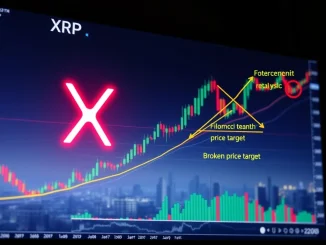
The crypto world is abuzz as Bitcoin price charts show a remarkable 13% surge over the past month, pushing the leading cryptocurrency to $118,090. This upward momentum has ignited optimism, yet beneath the surface, a palpable tension exists. Traders and analysts are now fixated on critical Bitcoin support levels, fully aware that a failure to hold these thresholds could trigger a significant downturn. The question on everyone’s mind: can Bitcoin sustain its climb, or are we on the brink of a substantial Bitcoin correction?
Bitcoin Price: Riding the Wave or Facing a Retreat?
Bitcoin’s recent performance has been a testament to its enduring appeal, climbing approximately 13% over the last 30 days. This impressive rally has seen the digital asset reach a high of $118,090, drawing considerable attention from both seasoned investors and new entrants. However, the journey upward has been anything but smooth, characterized by periods of intense volatility and strategic consolidation. The market’s current state is a delicate balance, where bullish enthusiasm contends with underlying bearish signals.
While the overall monthly gain is positive, the daily fluctuations tell a story of caution. Bitcoin recently retreated to $117,241 after a 2.3% decline, underscoring the fragility of its current consolidation phase. This dynamic creates a scenario where traders are constantly on edge, scrutinizing every price movement for clues about Bitcoin’s next major direction. The market is not just reacting to immediate buying or selling pressure but is also heavily influenced by technical indicators and broader macroeconomic trends that shape investor sentiment around the Bitcoin price.
Critical Thresholds: Why Bitcoin Support Levels are Crucial
The current market landscape for Bitcoin is defined by a series of critical technical thresholds, making Bitcoin support levels a focal point for analysts. These levels act as defensive lines, where buying interest is expected to step in and prevent further price declines. Their importance cannot be overstated, as a break below them can signal a shift in market sentiment from bullish to bearish.
- The $108,000 Pivotal Marker: Prominent analyst DonAlt has singled out the $108,000 level as a crucial line in the sand. “Losing this level would signal something is going wrong,” he warned, suggesting that a breakdown here could easily trigger a 9% correction. For many traders, this is the ultimate litmus test for Bitcoin’s short-term health. A decisive move below this point would necessitate a reassessment of long positions and could accelerate selling pressure.
- The Rising Wedge Pattern: Adding to the technical concerns, Captain Faibik, another respected analyst, has pointed to a “rising wedge” pattern in Bitcoin’s price action. This formation is typically considered bearish, often preceding a downward momentum after a breakout. Such patterns indicate a loss of bullish momentum and increasing seller conviction. If Bitcoin confirms this pattern by breaking downwards, it could pave the way for a more significant fall, potentially below the psychological $100,000 mark.
- The $117,000-$120,000 Trading Range: Despite these warnings, Bitcoin has shown resilience, stabilizing near $117,000. However, it remains trapped within a narrow $117,000–$120,000 trading range. While this consolidation can be healthy, a prolonged inability to break above $120,000—a level viewed as both psychological and technical resistance—could erode investor confidence and reinforce bearish narratives. The market is waiting for a decisive move out of this range to confirm its next trend.
On-chain data further supports the idea of key defense zones. Metrics like the STH (Short-Term Holder) realized price chart reveal specific price points where short-term holders acquired their Bitcoin, often acting as strong support levels. However, prolonged tests of the $117,000 level could gradually weaken these defense zones, making them more susceptible to a breach.
What’s Happening in the Broader Crypto Market?
The performance of the wider crypto market often provides crucial context for Bitcoin’s movements. While Bitcoin aims for stability, many altcoins have experienced significant headwinds, raising concerns about capital rotation and overall market sentiment.
Recent data indicates considerable declines in major altcoins:
- Ethereum (ETH): The second-largest cryptocurrency has been testing its $3,515 support level. A breakdown here could signal further weakness, potentially impacting the broader market given Ethereum’s significant influence.
- XRP: Ripple’s native token, XRP, has fallen below the $3.00 mark, indicating a bearish trend.
- Other Altcoins: While not explicitly detailed in the provided content, the general weakness in these major altcoins often suggests that capital might be flowing out of riskier assets, or simply not entering the market with the same vigor. This trend can exacerbate downward pressure on Bitcoin, as a healthy altcoin market often signifies broader investor confidence.
The interrelation between Bitcoin and altcoins is a complex dance. Sometimes, altcoin rallies signal an “altseason” where capital flows from Bitcoin into smaller cap coins, indicating high risk appetite. Conversely, altcoin weakness can suggest a flight to safety (often back to Bitcoin, or out of crypto entirely), or a general market downturn. In the current scenario, altcoin declines raise concerns about a potential outflow of capital from the entire digital asset space, which would naturally put pressure on Bitcoin.
Can Bitcoin Avoid a Significant Bitcoin Correction?
The specter of a Bitcoin correction looms large, with analysts closely watching whether the current consolidation is merely a pause before another leg up, or a precursor to a more substantial downturn. A 9% correction from current levels would bring Bitcoin dangerously close to the $108,000 pivotal support, and potentially even lower if momentum shifts decisively bearish.
The “rising wedge” pattern highlighted by Captain Faibik is a key technical warning. If this pattern plays out as historically expected, it would lead to a downward breakout, validating fears of a significant correction. Such a move could be swift and unforgiving, catching unprepared traders off guard.
However, there are mitigating factors. On-chain data suggests reduced liquidation risks compared to previous sell-offs. This means that while prices might drop, the cascade of forced selling that often exacerbates corrections might be less severe. This resilience indicates that a segment of the market remains strong, potentially absorbing selling pressure.
The ability of Bitcoin to avoid a deep correction will largely depend on its capacity to hold key support levels and attract renewed buying interest. A failure to retest and break above the $120,000 resistance could reinforce bearish narratives, making a correction more likely. Conversely, a strong bounce from current levels, ideally breaking the $120,000 barrier, would invalidate many bearish signals and potentially pave the way for further gains.
The Double-Edged Sword of Institutional Buying
One of the most significant factors influencing Bitcoin’s recent resilience and its potential to avert a deeper Bitcoin correction is the consistent inflow from institutional buying. Corporations and large investment funds have increasingly added Bitcoin to their portfolios, providing a steady demand floor that has helped stabilize the asset amidst volatility.
- A Key Driver of Resilience: DonAlt emphasized that sustained buying from corporations has been a crucial driver of Bitcoin’s ability to withstand selling pressure. This influx of large capital provides a level of stability that was largely absent in earlier crypto market cycles, where retail speculation was the primary force. Institutional investors often have longer time horizons and deeper pockets, making their buying less reactive to short-term price swings.
- The Risk of Slowdown: However, this reliance on institutional demand presents a double-edged sword. DonAlt cautioned, “If companies cease purchasing, the uptrend ends, and prices could sharply decline.” A slowdown or cessation of this activity could introduce significant volatility and amplify selling pressure, as a major source of demand diminishes. This highlights the market’s reliance on external capital inflows rather than purely organic retail growth.
- Treasury Buying and Macro Signals: Currently, treasury buying—where companies hold Bitcoin as part of their corporate reserves—is offsetting some risks. This trend signifies a growing acceptance of Bitcoin as a legitimate store of value and a hedge against inflation. Yet, despite this institutional interest, Bitcoin has struggled to decisively break above the $120,000 resistance. This suggests that while institutional demand provides a floor, it might not be strong enough on its own to propel Bitcoin into a new bullish phase without broader macroeconomic tailwinds.
The interplay between institutional activity and macroeconomic signals will be paramount. Should global economic conditions worsen, or if institutional risk appetite diminishes, the positive impact of their buying could quickly wane, leaving Bitcoin vulnerable to market forces.
Navigating the Volatility: Actionable Insights for Traders
In a market characterized by both impressive gains and significant risks, prudent decision-making is essential. For traders and investors navigating Bitcoin’s current trajectory, several actionable insights can help mitigate risks and capitalize on potential opportunities:
- Monitor Key Support Levels Religiously: The $108,000 and $117,000 levels are not just numbers; they are battlegrounds. A decisive break below $108,000, especially on high volume, should be a strong signal for reassessing positions and potentially reducing exposure. Conversely, a strong bounce from these levels could indicate continued bullish resilience.
- Watch for Confirmation of Technical Patterns: Pay close attention to patterns like the “rising wedge.” While these are indicators, they require confirmation. A confirmed downward breakout from such a pattern would be a critical signal to adjust strategies.
- Track Institutional Flow: Keep an eye on reports and on-chain data related to institutional buying and selling. A noticeable slowdown in corporate accumulation or significant outflows from institutional products (like Bitcoin ETFs, if applicable) could signal a shift in market dynamics.
- Assess Broader Crypto Market Health: The performance of altcoins like Ethereum and XRP offers insights into overall market risk appetite. Sustained weakness in altcoins could indicate capital rotation out of the crypto space entirely, putting more pressure on Bitcoin.
- Set Clear Entry and Exit Strategies: Given the volatility, having predefined profit targets and stop-loss orders is crucial. This helps manage risk and prevents emotional decision-making during rapid price swings.
- Consider Macroeconomic Factors: Global economic indicators, inflation data, interest rate decisions, and geopolitical events can all influence institutional sentiment and, by extension, Bitcoin’s performance. Staying informed about these broader trends is vital.
Conclusion: A Pivotal Juncture for Bitcoin’s Trajectory
Bitcoin stands at a pivotal juncture, where its impressive monthly gains are overshadowed by the looming threat of a significant Bitcoin correction. The interplay between critical Bitcoin support levels, the broader health of the crypto market, and the sustained yet fragile impact of institutional buying will dictate its immediate future. While resilience has been shown near $117,000, the inability to decisively break above $120,000 keeps bearish narratives alive. The coming days and weeks will offer critical signals, determining whether Bitcoin can consolidate its recent gains or if it will be forced to retest deeper support. Investors are advised to remain vigilant, adapting their strategies as new information emerges. The outcome of this delicate balance will not only shape Bitcoin’s trajectory but also influence broader sentiment across the entire digital asset sector.
Frequently Asked Questions (FAQs)
Q1: Why is Bitcoin’s $108,000 level so important?
A1: The $108,000 level is highlighted by analysts like DonAlt as a pivotal support. A breakdown below this point could signal a significant shift in market sentiment, potentially triggering a 9% correction and indicating deeper underlying issues with the current uptrend.
Q2: What is a “rising wedge” pattern in Bitcoin’s price action?
A2: A “rising wedge” is a bearish technical pattern identified by Captain Faibik. It forms when price action consolidates upwards within two converging trend lines, but with decreasing momentum. Historically, it often precedes a downward breakout and significant price correction.
Q3: How does institutional buying affect Bitcoin’s price?
A3: Institutional buying provides a strong demand floor for Bitcoin, contributing to its resilience and helping stabilize its price. Corporations adding Bitcoin to their portfolios can absorb selling pressure and drive prices higher. However, a slowdown in this buying could remove a key support, leading to increased volatility and potential declines.
Q4: Are altcoins impacting Bitcoin’s current performance?
A4: Yes, the weakness in major altcoins like Ethereum and XRP is a concern. Significant declines in altcoins can indicate a broader flight of capital from the crypto market, potentially exacerbating downward pressure on Bitcoin, as investors might be reducing overall crypto exposure.
Q5: What is the significance of the $117,000-$120,000 trading range?
A5: This range represents a consolidation phase for Bitcoin. While stabilizing near $117,000 shows some resilience, the inability to decisively break above the $120,000 resistance level (a key psychological and technical barrier) can lead to investor fatigue and reinforce bearish sentiments, potentially making a correction more likely.
Q6: What should investors monitor to navigate Bitcoin’s current volatility?
A6: Investors should closely monitor key support levels ($108,000, $117,000), watch for confirmation of bearish technical patterns like the rising wedge, track institutional buying trends, assess the overall health of the altcoin market, and stay informed about macroeconomic signals. Having clear entry/exit strategies is also crucial.



